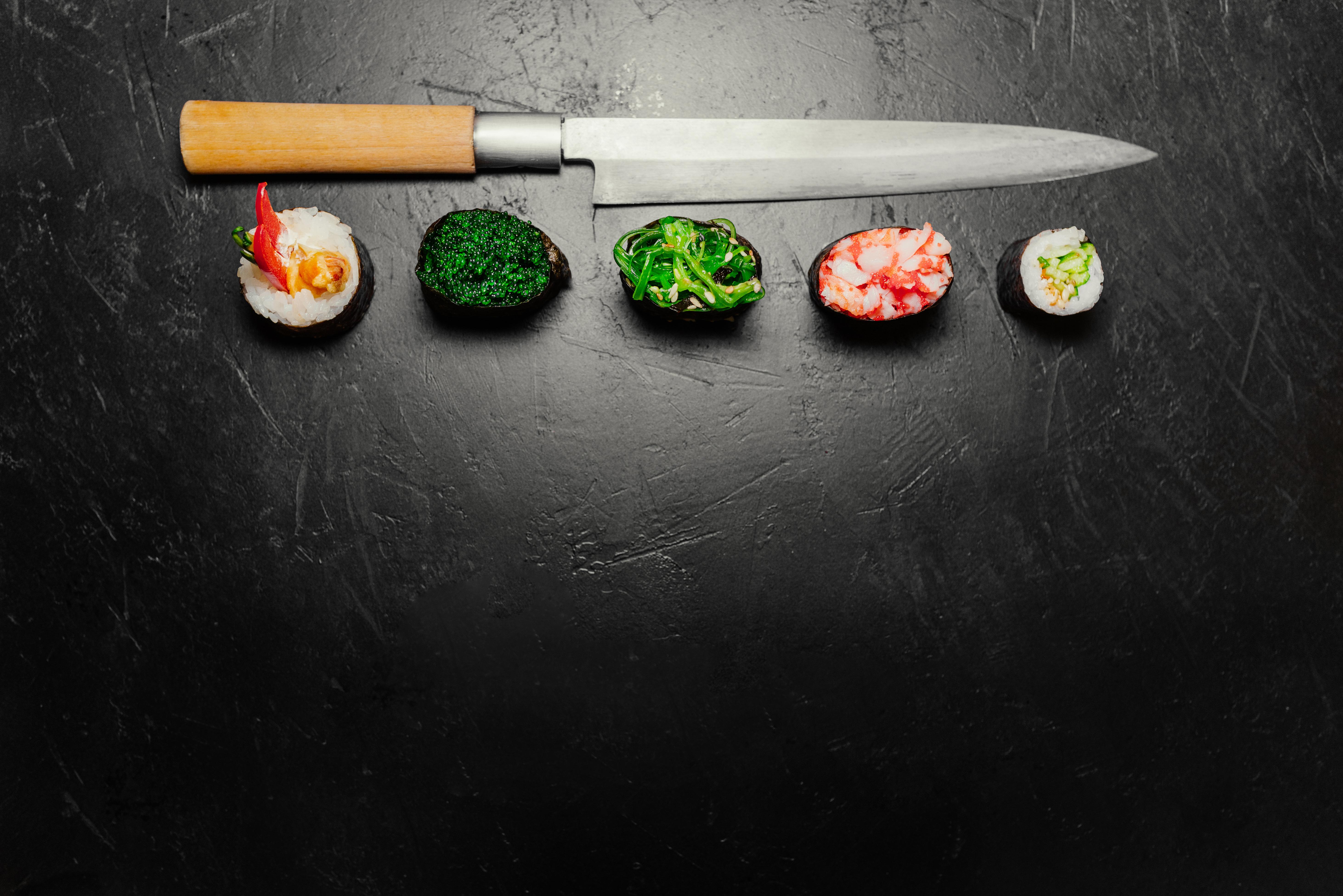The kiritsuke knife is one of the most prestigious Japanese chef’s knives, traditionally reserved for master chefs in Japanese kitchens. Known for its long, flat blade and sharp angled tip, it combines the functions of the usuba (vegetable knife) and the yanagiba (sashimi knife). This dual-purpose design makes it versatile, elegant, and highly efficient for precision cutting. Today, it is admired by professional chefs worldwide and has become increasingly popular among serious home cooks seeking a high-performing blade.
What Is a Kiritsuke Knife?
A kiritsuke knife is a hybrid between two traditional Japanese knives: the yanagiba (used for slicing fish) and the usuba (used for cutting vegetables). It features a long blade with a straight edge and a clipped point, giving it a distinctive sword-like appearance.
In Japanese culinary tradition, the kiritsuke was considered a status symbol, often carried only by the executive chef in a kitchen. Today, however, professional chefs and home cooks alike appreciate its versatility.
Key Features of a Kiritsuke Knife
Blade Shape and Design
The blade of a kiritsuke is typically between 8 and 12 inches long. Its straight edge allows for long, clean cuts, while the angled tip makes it ideal for precision work. This unique profile makes it suitable for slicing fish, chopping vegetables, and even delicate tasks like garnishing.
Single vs. Double Bevel
Traditional kiritsuke knives are single bevel, meaning they are sharpened on one side only. This design delivers razor-sharp precision but requires skill to handle correctly. Modern versions often come in double bevel, making them easier for most cooks to use.
Materials and Craftsmanship
High-carbon steel and Damascus steel are common materials for kiritsuke blades. These metals hold a sharp edge and resist wear, though they require proper care to prevent rust. Many premium kiritsuke knives also feature intricate patterns on the blade, showcasing traditional Japanese forging techniques.
Why Chefs Value the Kiritsuke Knife
Versatility in the Kitchen
Unlike specialized knives that serve only one function, the kiritsuke can handle multiple tasks. It excels at slicing proteins, cutting vegetables, and fine detail work, making it an all-in-one solution for serious cooks.
Precision Cutting
The long, straight edge of the kiritsuke allows for controlled, fluid motions. This makes it perfect for creating uniform slices of sashimi, paper-thin vegetables, or even precise decorative cuts.
Symbol of Skill
Traditionally, the kiritsuke was given only to the head chef, symbolizing mastery in Japanese cuisine. Owning and using this knife today still carries that prestige, signaling respect for craftsmanship and culinary artistry.
How to Use a Kiritsuke Knife Properly
Slicing Fish and Meat
The kiritsuke is excellent for preparing raw fish dishes like sashimi. Its sharp edge ensures clean slices without tearing delicate flesh. When working with meats, it glides smoothly through muscle fibers, minimizing damage and preserving texture.
Chopping Vegetables
Thanks to its straight edge, the kiritsuke is ideal for push-cutting vegetables. It handles root vegetables, leafy greens, and herbs with equal ease. The flat edge also makes it effective for transferring chopped ingredients from the board to the pan.
Delicate Garnishing
The pointed tip of the kiritsuke allows for detailed work such as trimming, peeling, or scoring vegetables for presentation. This versatility makes it a favorite tool for chefs who value aesthetics as much as taste.
Caring for a Kiritsuke Knife
Proper Cleaning
Always hand wash your kiritsuke with warm water and mild soap. Avoid dishwashers, as they can damage the blade and handle. Dry it immediately to prevent rust, especially if it’s made of high-carbon steel.
Sharpening and Honing
A kiritsuke requires regular sharpening to maintain its edge. For single-bevel versions, sharpening should be done carefully to preserve the traditional angle. Double-bevel versions are easier for beginners to maintain with a whetstone.
Safe Storage
Store your kiritsuke in a knife block, magnetic strip, or protective sheath to protect both the blade and your fingers. Proper storage also prevents the knife from dulling prematurely.
Choosing the Right Kiritsuke Knife
When selecting a kiritsuke, consider your cooking style and experience. If you are comfortable with traditional Japanese knives, a single-bevel kiritsuke offers unmatched precision. If you prefer versatility and ease of use, a double-bevel version is ideal.
Pay attention to the handle as well. Japanese-style wa handles are lightweight and allow for precise control, while Western handles provide a firmer grip.
For a premium option, explore this handcrafted kiritsuke knife with a copper and carbon fiber handle. It blends traditional Japanese design with modern durability, making it an excellent choice for chefs and enthusiasts alike.
Kiritsuke Knife vs. Other Japanese Knives
Kiritsuke vs. Gyuto
The gyuto is the Japanese equivalent of a Western chef’s knife. It has a curved edge, making it ideal for rocking cuts. The kiritsuke, with its flat edge, is better suited for push cuts and precision slicing.
Kiritsuke vs. Yanagiba
The yanagiba is a specialist sushi knife designed solely for slicing raw fish. The kiritsuke offers similar slicing power but with added versatility for vegetables and other tasks.
Kiritsuke vs. Usuba
The usuba is a vegetable knife with a flat blade, perfect for intricate vegetable work. The kiritsuke borrows this strength but adds the slicing power of a yanagiba, making it more versatile overall.
Is a Kiritsuke Knife Right for You?
The kiritsuke knife is not just a tool; it’s a statement piece in the kitchen. Its blend of tradition, precision, and versatility makes it an exceptional choice for those who value both performance and artistry in cooking.
Whether you are a professional chef or a passionate home cook, the kiritsuke can elevate your culinary experience. With proper care, it will serve as a reliable companion for years to come.



